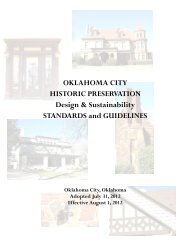OKC Plan, 2000-2020 - City of Oklahoma City
OKC Plan, 2000-2020 - City of Oklahoma City
OKC Plan, 2000-2020 - City of Oklahoma City
Create successful ePaper yourself
Turn your PDF publications into a flip-book with our unique Google optimized e-Paper software.
Actions<br />
General<br />
Continue to pursue a more balanced and integrated transportation system for <strong>Oklahoma</strong> <strong>City</strong> that<br />
provides for a wide range <strong>of</strong> transportation alternatives that include driving, biking, walking, as<br />
well as transit (both bus and trolley), rail, light rail, and air services.<br />
Make those dependent on transit (the handicapped, the elderly, and youth) a top consideration in<br />
planning and implementing transportation facilities and services.<br />
Establish an action plan with dates and a method <strong>of</strong> funding.<br />
Reclaim the area around Union Station for redevelopment.<br />
Streets, Highways, and Freeways (including I-40 realignment)<br />
Review <strong>Oklahoma</strong> <strong>City</strong>’s functional classification street plan and subdivision regulations to<br />
explore the use <strong>of</strong> narrower paved streets, and require sidewalks and landscaping.<br />
Prohibit large trucks from traveling through the central city. Route these trucks around the<br />
central city via existing bypasses. Alert truck drivers about these mandatory bypasses at weigh<br />
stations upon entering the state.<br />
Consider the cost <strong>of</strong> maintaining current roads before beginning to build new roads. Set aside<br />
maintenance funds for roads.<br />
Explore alternatives to building new highways. Implement and finance alternative modes <strong>of</strong><br />
transportation before building new roadways. Look to other communities for examples <strong>of</strong> coordinated<br />
transportation planning.<br />
Preserve, to the maximum extent possible, existing rail infrastructure in relocating the<br />
I-40/Crosstown Expressway.<br />
Restrict large trucks from using neighborhood streets.<br />
Continue ongoing air quality improvement and traffic congestion mitigation measures,<br />
specifically traffic signal timing and High Occupancy Vehicle or car pool lanes as warranted.<br />
Identify regional mobility corridors and develop supportive transit and land use strategies for<br />
each.<br />
43

















